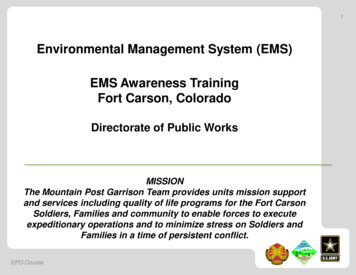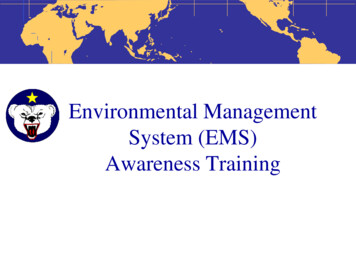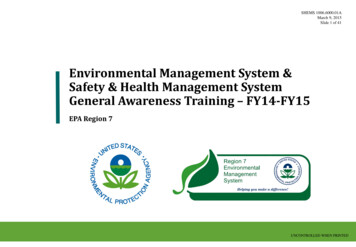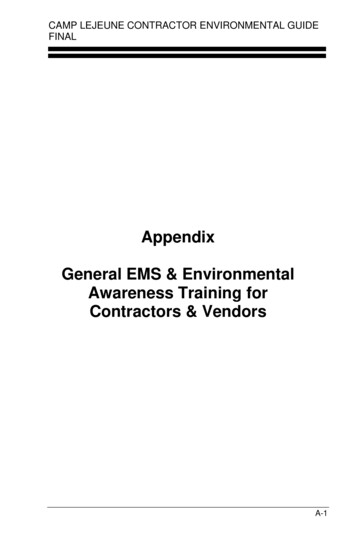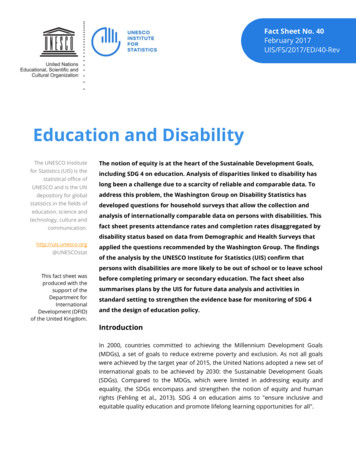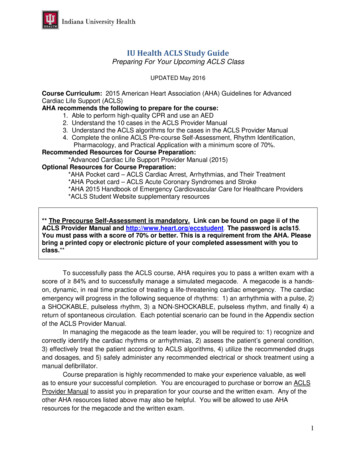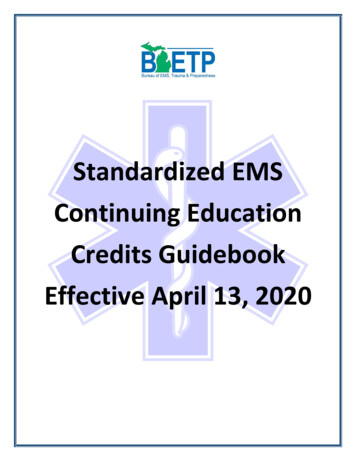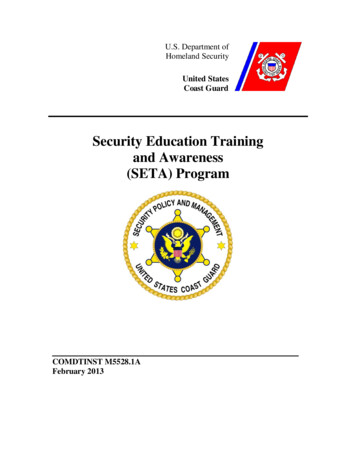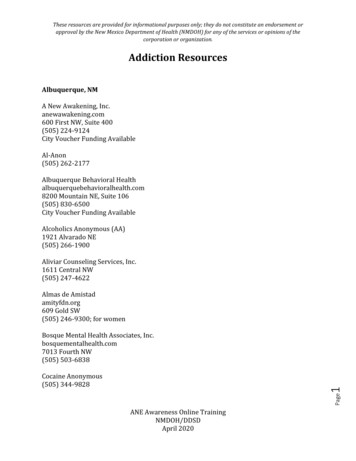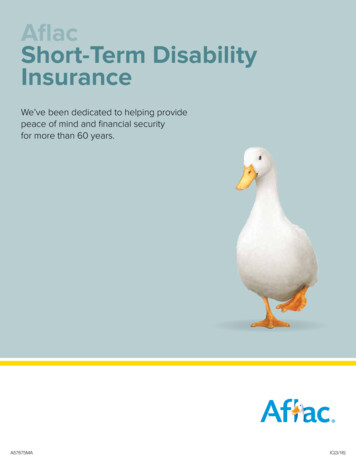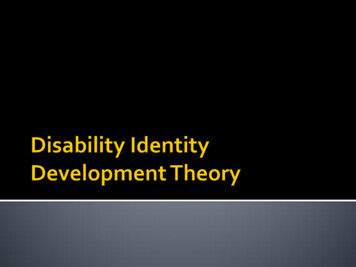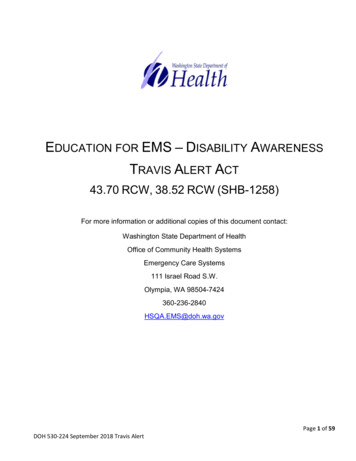
Transcription
EDUCATION FOR EMS – DISABILITY AWARENESSTRAVIS ALERT ACT43.70 RCW, 38.52 RCW (SHB-1258)For more information or additional copies of this document contact:Washington State Department of HealthOffice of Community Health SystemsEmergency Care Systems111 Israel Road S.W.Olympia, WA 98504-7424360-236-2840HSQA.EMS@doh.wa.govDOH 530-224 September 2018 Travis AlertPage 1 of 59
Special acknowledgements to:Holly Bahme Lytle, Isaac FoundationBob Berschauer, Washington Ambulance AssociationKim Conner, Washington State Independent Living CouncilJohn Goodman, Spokane Fire DepartmentTim Hoover, Washington Council of FirefightersJim House, Washington State Independent Living CouncilNicole Johnson, Pierce County Emergency ManagementTravis, Theresa and Darren King, StakeholdersSerina McWha, Pierce County Emergency ManagementKimberly Meck, Alliance of People with DisabilitiesKatie Mirkovich, Washington State Department of Social and Health ServicesWendy Moudy, Yakima County EMSNorma Pancake, Pierce County EMS Office, Washington State Firefighters AssociationDavid Roth, Washington Autism AdvocacyBill Slosson, Washington State Fire Marshal’s OfficeMika Timmons, Washington Autism AdvocacyCassie Villegas, Washington State Independent Living CouncilDawn Felt, Washington State Department of HealthCatie Holstein, Washington State Department of HealthChristy Cammarata, Washington State Department of HealthHilary Dykstra, Washington State Department of HealthDr. Eric Cooper, Medical Program Director Chair, Snohomish CountyDr. Ben Maltz, EMS Medical Program Director, Yakima CountyDr. Sara Ragsdale, EMS Medical Program Director, Pend Oreille CountyDr. Lynn Wittwer, EMS Medical Program Director, Clark CountyDOH 530-224 September 2018 Travis AlertPage 2 of 59
Department of Health Office of Community Health SystemsWashington State Department of Social and Health ServicesWashington State Fire Marshal’s OfficeWashington Office of Superintendent of Public InstructionWashington State Council of FirefightersWashington State Firefighters AssociationDOH 530-224 September 2018 Travis AlertPage 3 of 59
Table of ContentsBackground / Scope . 7Course Guide. 8Participant Requirements . 8Course Completion Requirements. 8Course Length. 8Washington State Training Course Forms . 8Travis Alert Curriculum and PowerPoint . 8Lead Instructor . 8Course Medical Director . 8Facilities . 8Training Program Goals . 9Cognitive Goals. 9Affective Goals . 9Psychomotor Goals . 9Building Community Understanding . 10Definition of Disability/Impairment . 10People First Language. 10Essential Tips / Etiquette . 11Communication Techniques . 12Community Outreach Suggestions . 13Disabilities Modules . 14Module 1: People with Mobility/Physical Impairments. 141.Definitions . 142.Examples of Conditions with Mobility or Physical Impairments . 143.Essential Tips / Etiquette . 144.Suggested Communication Techniques . 155.Providing Assistance and Removing Barriers . 15Module 2: People with Sensory Impairments . 17Module 2A: d/Deaf, Hard of Hearing . 171.Definitions . 172.Examples of what a person who is d/Deaf or hard of hearing may display:. 183.Essential Tips / Etiquette . 184.Suggested Communication Techniques . 195.Providing Assistance and Removing Barriers . 19DOH 530-224 September 2018 Travis AlertPage 4 of 59
Module 2B: Blind, Low Vision or Visual Impairment . 211.Definitions . 212.Examples of Possible Conditions That May Exhibit These Characteristics . 223.Essential Tips / Etiquette . 224.Suggested Communication Techniques . 235.Providing Assistance and Removing Barriers . 23Module 2C: Deaf-Blind . 241.Definitions . 243.Essential Tips / Etiquette . 254.Suggested Communication Techniques . 255.Providing Assistance and Removing Barriers . 27Module 3: People with Mental Health, Cognitive, Intellectual, Developmental Impairments . 283A: Mental Health (Psychiatric, Behavioral, Emotional) . 301.Definitions . 302.Examples of Possible Conditions That May Mimic Mental Health Disorders. 323.Essential Tips / Etiquette . 324.Suggested Communication Techniques . 335.Providing Assistance and Removing Barriers . 333B: Cognitive (Learning, Intellectual, Developmental, TBI) . 341.Definition . 342.Examples of Possible Conditions That May Exhibit These Characteristics . 353.Essential Tips / Etiquette . 354.Suggested Communication Techniques . 363C: Autism. 381.Definition . 382.Examples of Possible Conditions That May Exhibit Similar Characteristics . 393.Essential Tips / Etiquette . 394.Suggested Communication Techniques . 415.Providing Assistance and Removing Barriers . 41Module 4: People with Service Animals . 421.Definitions . 42Service Animals . 422.Examples of Types of Service Animals . 433.Essential Tips / Etiquette . 464.Suggested Communication Techniques . 47DOH 530-224 September 2018 Travis AlertPage 5 of 59
5.Providing Assistance and Removing Barriers . 47Summary of Etiquette, Communication and Tips. 48General Overall Tips / Etiquette . 48General Overall Communication . 49Appendices . 50Provider tools . 50Picture Cues. 51Ability Checklist . 54Reference Bibliography . 56Training Resources . 58DOH 530-224 September 2018 Travis AlertPage 6 of 59
Background / ScopeThe Washington State Legislature passed and Governor Inslee subsequently signed into lawSubstitute House Bill 1258 (also known as the Travis Alert Act). The bill added new sections toRCW 38.53 – Emergency Management as well as RCW 43.70 Department of Health.The new section added to RCW 43.70 – Department of Health requires the Department of Health(DOH) to collaborate with the Department of Social and Health Services (DSHS), State FireMarshal’s Office, Superintendent of Public Instruction, and Washington State Council ofFirefighters to review existing training programs both locally and nationally to design a statewidetraining program that will familiarize fire department and emergency medical service personnelwith the techniques, procedures, and protocols for best handling situations in which people withdisabilities are present at the scene of an emergency.The definition of “Person with disabilities” per SHB 1258: individuals who have been diagnosedmedically to have a physical, mental, emotional, intellectual, behavioral, developmental, orsensory disability.The goals as stated in SBH 1258 (2017): Maximize the safety of persons with disabilitiesMinimize the likelihood of injury to persons with disabilitiesPromote the safety of all persons presentFire department and emergency medical services personnel can easily and quicklydetermine the specific scenario into which they are entering.The scope of the Travis Alert Act project is to design a statewide training program that willfamiliarize the fire department and emergency medical service personnel with techniques,procedures and protocols for best handling situations in which people with disabilities are presentat the scene of an emergency.The program must include: A checklist of disabilities;Symptoms of such disabilities, andActions to take and not to take relevant to a particular disability.The department must make the training program available on the department’s website for use byall fire departments and emergency medical services agencies in the state. The department mustinclude on its website a list of public and private nonprofit disability related agencies andorganizations, and the contact information of each agency and organization.Fire departments and emergency medical services agencies must ensure their employees areadequately trained and familiarized with techniques, procedures and protocols for best handlingsituations in which people with particular disabilities are present at the scene of an emergency.DOH 530-224 September 2018 Travis AlertPage 7 of 59
Course GuideParticipant RequirementsFire department and emergency medical services personnel who respond to the scene of anemergency are required to complete this training. It may be combined with initial or ongoingtraining. There is not a legislative requirement that the training be repeated; however, it isrecommended that it be incorporated into continuing education training / OTEP.Course Completion RequirementsCourse participants must be adequately trained in and familiarized with techniques, procedures,and protocols for best handling situations in which people with particular disabilities are present atthe scene of an emergency.Course LengthRecommended length minimum of two hours.Washington State Training Course FormsCourse roster to be maintained by fire department and emergency medical services agency. Noapplication for DOH required – no credential to be issued by DOH.Travis Alert Curriculum and PowerPointThis curriculum and PowerPoint are located here on the DOH website. Both can also berequested by contacting DOH Emergency Care System at 360-236-2840 or by sending an emailto HSQA.EMS@doh.wa.gov.Lead InstructorTravis Alert Act training should be conducted by people experienced in the delivery of EMSeducation and practical application of scene and patient management, such as senior EMSinstructors or other people approved by the medical program director to teach continuingeducation. Content experts should be used to instruct as available by area.Course Medical DirectorMedical direction is an essential component of out-of-hospital training, and physician involvementshould be in place for all aspects of EMS education. The course medical director should be thecounty medical program director (MPD) or an MPD delegated training physician who will act asthe medical authority regarding course content, procedures, and protocols.FacilitiesThe course may be conducted via online or video presentation. When conducted in person, thefacility should sufficient have space for seating all students. The facility should be ADA-compliantand barrier-free. The facility should be well lit for adequate viewing of various types of visual aidsand demonstrations. Heating and ventilation should assure student and instructor comfort. Seatsshould be comfortable with availability of desk tops or tables for taking notes. There should be anadequate number of tables for display of equipment, medical supplies, and training aids. Aprojection screen and appropriate audiovisual equipment should be located in the presentationfacility.DOH 530-224 September 2018 Travis AlertPage 8 of 59
Training Program GoalsAt the conclusion of the training program, fire department and emergency medical servicespersonnel will achieve:Cognitive Goals Identify ways to maximize the safety on the scene for patients, providers and the public.Identify ways to minimize the likelihood of injury to a person with disabilities on the scene ofan emergency.Identify the following for each main disability topic:o Definitions,o Essential tips and etiquette,o Best practices for communication techniques,o Best practices for providing assistance and removing barriers.Apply the checklist for disabilities.Identify r
Page 1 of 59 DOH 530-224 September 2018 Travis Alert . EDUCATION FOR EMS – DISABILITY AWARENESS. TRAVIS ALERT ACT. 43.70 RCW, 38.52 RCW (SHB-1258) For more information or additional copies of this document contact:File Size: 1MBPage Count: 59People also search forcdc ems guidelinescdc ems guidelines
